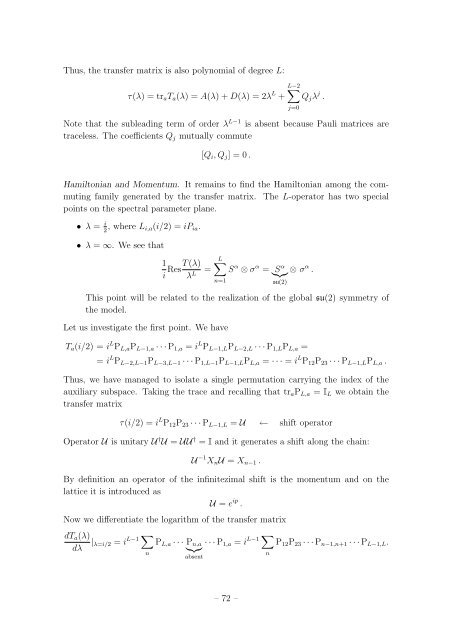Student Seminar: Classical and Quantum Integrable Systems
Student Seminar: Classical and Quantum Integrable Systems
Student Seminar: Classical and Quantum Integrable Systems
You also want an ePaper? Increase the reach of your titles
YUMPU automatically turns print PDFs into web optimized ePapers that Google loves.
Thus, the transfer matrix is also polynomial of degree L:<br />
∑L−2<br />
τ(λ) = tr a T a (λ) = A(λ) + D(λ) = 2λ L + Q j λ j .<br />
Note that the subleading term of order λ L−1 is absent because Pauli matrices are<br />
traceless. The coefficients Q j mutually commute<br />
[Q i , Q j ] = 0 .<br />
j=0<br />
Hamiltonian <strong>and</strong> Momentum. It remains to find the Hamiltonian among the commuting<br />
family generated by the transfer matrix. The L-operator has two special<br />
points on the spectral parameter plane.<br />
• λ = i 2 , where L i,a(i/2) = iP ia .<br />
• λ = ∞. We see that<br />
1 (λ)<br />
ResT<br />
i λ = ∑ L L<br />
n=1<br />
S α ⊗ σ α = S α<br />
}{{}<br />
su(2)<br />
⊗ σ α .<br />
This point will be related to the realization of the global su(2) symmetry of<br />
the model.<br />
Let us investigate the first point. We have<br />
T a (i/2) = i L P L,a P L−1,a · · · P 1,a = i L P L−1,L P L−2,L · · · P 1,L P L,a =<br />
= i L P L−2,L−1 P L−3,L−1 · · · P 1,L−1 P L−1,L P L,a = · · · = i L P 12 P 23 · · · P L−1,L P L,a .<br />
Thus, we have managed to isolate a single permutation carrying the index of the<br />
auxiliary subspace. Taking the trace <strong>and</strong> recalling that tr a P L,a = I L we obtain the<br />
transfer matrix<br />
τ(i/2) = i L P 12 P 23 · · · P L−1,L = U ← shift operator<br />
Operator U is unitary U † U = UU † = I <strong>and</strong> it generates a shift along the chain:<br />
U −1 X n U = X n−1 .<br />
By definition an operator of the infinitezimal shift is the momentum <strong>and</strong> on the<br />
lattice it is introduced as<br />
U = e ip .<br />
Now we differentiate the logarithm of the transfer matrix<br />
dT a (λ)<br />
dλ<br />
| λ=i/2 = i ∑ L−1 n<br />
P L,a · · · P<br />
}{{} n,a · · · P 1,a = i ∑ L−1 n<br />
absent<br />
P 12 P 23 · · · P n−1,n+1 · · · P L−1,L .<br />
– 72 –

















